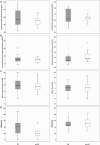Insights into perceived listening difficulties post COVID-19 infection: no measurable hearing difficulty on clinical tests despite increased self-reported listening effort
- PMID: 37273701
- PMCID: PMC10233052
- DOI: 10.3389/fneur.2023.1172441
Insights into perceived listening difficulties post COVID-19 infection: no measurable hearing difficulty on clinical tests despite increased self-reported listening effort
Abstract
Objective: The aim was to use a battery of clinic-based auditory assessment procedures to compare participants with and without self-reported hearing difficulties following a confirmed COVID-19 infection. A further aim was to compare the groups on self-reported measures of listening effort and fatigue.
Methods: There were 25 participants in each group (age range 20-59 years, 80% females). Participants were recruited after a minimum of 4 weeks of testing positive. Hearing assessment involved tympanometry, acoustic reflex thresholds, pure-tone audiometry (PTA; 0.25-14 kHz), and distortion product otoacoustic emissions (DPOAEs; 0.5-10 kHz). Listening effort was assessed using the Arabic version of the Effort Assessment Scale (EAS-A) and fatigue was assessed using the Arabic version of the Fatigue Assessment Scale (FAS-A).
Results: There was no difference between groups on any measure except for greater self-reported listening effort in the perceived hearing difficulty group (p = 0.01).
Conclusion: The only difference between groups was self-reported listening effort. This could be due to a subclinical auditory deficit following COVID-19, increased listening effort due to the impact of COVID-19 on cognitive processes, or a psychosomatic response/health anxiety.
Keywords: COVID-19; cognition; fatigue; listening effort; psychology; sub-clinical hearing loss.
Copyright © 2023 Alhanbali, Alkharabshe, Alanati, Joudeh and Munro.
Conflict of interest statement
The authors declare that the research was conducted in the absence of any commercial or financial relationships that could be construed as a potential conflict of interest.
Figures

References
-
- World Health Organization . Coronavirus Disease (COVID-19): Situation Report. Geneva: World Health Organization; (2022).
-
- The National Institute for Health and Care Excellence . COVID-19 Rapid Guideline: Managing the Longterm Effects of COVID-19. Scotland: NICE; (2022).
LinkOut - more resources
Full Text Sources
Research Materials
Miscellaneous

